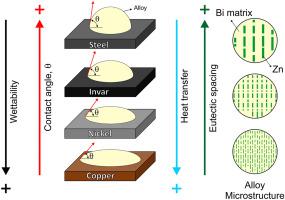当前位置:
X-MOL 学术
›
Int. J. Therm. Sci.
›
论文详情
Our official English website, www.x-mol.net, welcomes your
feedback! (Note: you will need to create a separate account there.)
Interface evaluation of a Bi–Zn eutectic solder alloy: Effects of different substrate materials on thermal contact conductance
International Journal of Thermal Sciences ( IF 4.9 ) Pub Date : 2021-02-01 , DOI: 10.1016/j.ijthermalsci.2020.106685 Rudimylla Septimio , Clarissa Cruz , Marcella Xavier , Thiago Lima , Amauri Garcia , José Eduardo Spinelli , Noé Cheung
International Journal of Thermal Sciences ( IF 4.9 ) Pub Date : 2021-02-01 , DOI: 10.1016/j.ijthermalsci.2020.106685 Rudimylla Septimio , Clarissa Cruz , Marcella Xavier , Thiago Lima , Amauri Garcia , José Eduardo Spinelli , Noé Cheung

|
Abstract Industry is searching for ways of improving the process control required for the manufacture of electronic circuitry. In this respect, a numerical mathematical model for thermal contact conductance of solder/substrate couples is developed based on an inverse heat conduction problem. The intention of this research is combining the model results and wetting experiments in order to determine if there is a compromise between them in the matter of the Bi–Zn eutectic alloy. Substrate materials considered as priority for the electronics industry were tested. It was found that the heat transfer coefficients (h) and the contact angles (θ) might be related to each other. The Bi–Zn/copper, Bi–Zn/nickel, Bi–Zn/Invar and Bi–Zn/steel couples, in this order, generated θ varying from the smallest to the largest as well as h from the largest to the smallest. Microstructural coarsening effect has been realized with higher spacing between Zn fibers (λZn) referring to a condition of worse heat extraction imposed by an alloy/substrate couple during solidification.
中文翻译:

Bi-Zn 共晶焊料合金的界面评估:不同基板材料对接触热导的影响
摘要 工业界正在寻找改善电子电路制造所需的过程控制的方法。在这方面,基于逆热传导问题开发了焊料/基板对的热接触传导的数值数学模型。本研究的目的是结合模型结果和润湿实验,以确定它们之间在 Bi-Zn 共晶合金问题上是否存在折衷。被视为电子行业优先考虑的基板材料进行了测试。发现传热系数 (h) 和接触角 (θ) 可能相互关联。Bi-Zn/铜、Bi-Zn/镍、Bi-Zn/Invar 和 Bi-Zn/钢对,按此顺序,生成的 θ 从最小到最大以及 h 从最大到最小。微观结构粗化效应已经通过 Zn 纤维之间的较大间距 (λZn) 实现,这是指凝固过程中合金/基材对施加的更差的热提取条件。
更新日期:2021-02-01
中文翻译:

Bi-Zn 共晶焊料合金的界面评估:不同基板材料对接触热导的影响
摘要 工业界正在寻找改善电子电路制造所需的过程控制的方法。在这方面,基于逆热传导问题开发了焊料/基板对的热接触传导的数值数学模型。本研究的目的是结合模型结果和润湿实验,以确定它们之间在 Bi-Zn 共晶合金问题上是否存在折衷。被视为电子行业优先考虑的基板材料进行了测试。发现传热系数 (h) 和接触角 (θ) 可能相互关联。Bi-Zn/铜、Bi-Zn/镍、Bi-Zn/Invar 和 Bi-Zn/钢对,按此顺序,生成的 θ 从最小到最大以及 h 从最大到最小。微观结构粗化效应已经通过 Zn 纤维之间的较大间距 (λZn) 实现,这是指凝固过程中合金/基材对施加的更差的热提取条件。











































 京公网安备 11010802027423号
京公网安备 11010802027423号